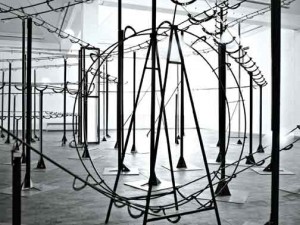« Reviews
Jeppe Hein

Jeppe Hein, Distance, 2004, iron, electrical motor, PVC balls, sensors, technical apparatus. Courtesy of Johann König, Berlin and 303 Gallery, New York. Photo: Simon Ladefoged.
Indianapolis Museum of Art - Indiana
By Kaytie Johnson
Dutch-born, Berlin-based artist Jeppe Hein has gained international recognition for his production of experiential, interactive artworks that frequently rely on human presence as both activating force and critical component. His interest in sculpture as an expanded field of social interaction-one in which the viewer is no longer a passive onlooker, but an active participant-results in sculptural works, projects and installations that interrogate the relationship between spectator, artwork and site/space. The performative and relational aspects of Hein’s work are fully realized in Distance (2004/2010), a large-scale, site-specific sculptural installation on view at the Indianapolis Museum of Art through September 5. Constructed from a modular system of steel tracks and resembling a Minimalist indoor rollercoaster, it reflects Hein’s interest in art as a game, one that is initiated by the viewer but ultimately controlled by the artwork itself.
As visitors enter the gallery, their movement triggers a hidden sensor, setting in motion a single, white PVC ball that travels the length of a track that twists, turns and continually switches back on itself in loops. After a ball quite literally drops, viewers are invited to follow along as it completes its circuit around the cyclical track, a relatively uncomplicated activity, save for the moments when it quickly loops back and forth through four small squares that perforate one of the gallery walls. The structure of the track controls not only the ball’s trajectory and speed, which is alternately infuriatingly slow, completely halted or dizzyingly fast, it also dictates the pace and movement of the viewer through the space. As multiple visitors enter the space, a new ball is launched onto the track every 15 seconds, making it nearly impossible to sustain a controlled focus on the movement of a lone ball. It’s far easier, and infinitely more interesting, to disengage and focus instead on the movement of multiple balls as they make their way around the track, a physical and visual shift that allows the viewer to experience and engage the work in its entirety.
The way in which Distance conceptually and physically engages the viewer brings to mind some of Hein’s other projects, most notably 360º Presence (2002), in which a sensor-controlled metal ball-stationary until someone enters the gallery-rolls around unpredictably, gathers momentum, and eventually crashes into most everything in its path. (In the six weeks it was on display at the Johann König gallery in Berlin, it obliterated everything at ground level.) While the activation of both works is dependent upon the presence of the audience, 360º Presence is more participatory and spontaneous; directly impelled by the movements of the viewer, it has a greater ability to manipulate and challenge the expectations, actions and reactions of the audience. Distance, on the other hand, is more automated machine than interactive sculpture. Once a ball is launched onto the track - the result of passive physical presence rather than calculated interaction - the viewer’s experience of the piece becomes mechanized and predictable, rather than playfully subjective.
A conflation of relational aesthetics, theme park thrill ride, institutional critique and Minimalist sculptural form, Distance heightens our physical experience of both art and space and allows us to assume a role seldom experienced in the rarified space of the “white cube”: the opportunity to become a participant as well as an observer.
(May 7 - September 5, 2010)
Kaytie Johnson is the director and curator of University Galleries, Museums and Collections at DePauw University in Greencastle, Indiana.
Filed Under: Reviews


































